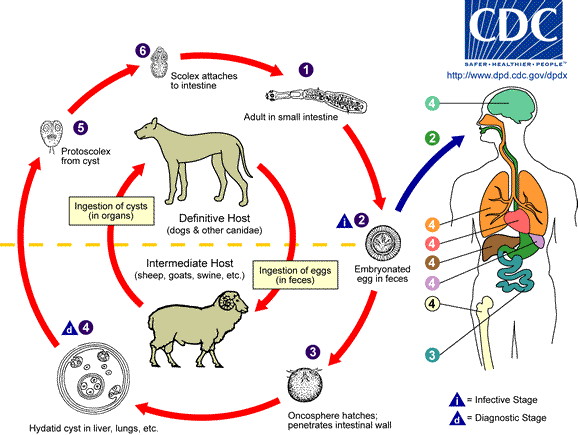Echinococcosis
Causal Agent:
Human echinococcosis (hydatidosis, or hydatid disease) is caused by the larval stages of cestodes (tapeworms) of the genus Echinococcus. Echinococcus granulosus causes cystic echinococcosis, the form most frequently encountered; E. multilocularis causes alveolar echinococcosis; E. vogeli causes polycystic echinococcosis; and E. oligarthrus is an extremely rare cause of human echinococcosis.
Life cycle of Echinococcus
The adult Echinococcus granulosus (3 to 6 mm long) resides in the small bowel of the definitive hosts, dogs or other canids. Gravid proglottids release eggs that are passed in the feces. After ingestion by a suitable intermediate host (under natural conditions: sheep, goat, swine, cattle, horses, camel), the egg hatches in the small bowel and releases an oncosphere that penetrates the intestinal wall and migrates through the circulatory system into various organs, especially the liver and lungs. In these organs, the oncosphere develops into a cyst that enlarges gradually, producing protoscolices and daughter cysts that fill the cyst interior. The definitive host becomes infected by ingesting the cyst-containing organs of the infected intermediate host. After ingestion, the protoscolices evaginate, attach to the intestinal mucosa , and develop into adult stages in 32 to 80 days. The same life cycle occurs with E. multilocularis (1.2 to 3.7 mm), with the following differences: the definitive hosts are foxes, and to a lesser extent dogs, cats, coyotes and wolves; the intermediate host are small rodents; and larval growth (in the liver) remains indefinitely in the proliferative stage, resulting in invasion of the surrounding tissues. With E. vogeli (up to 5.6 mm long), the definitive hosts are bush dogs and dogs; the intermediate hosts are rodents; and the larval stage (in the liver, lungs and other organs) develops both externally and internally, resulting in multiple vesicles. E. oligarthrus (up to 2.9 mm long) has a life cycle that involves wild felids as definitive hosts and rodents as intermediate hosts. Humans become infected by ingesting eggs , with resulting release of oncospheres in the intestine and the development of cysts in various organs.
Geographic Distribution:
E. granulosus occurs practically worldwide, and more frequently in rural, grazing areas where dogs ingest organs from infected animals. E. multilocularis occurs in the northern hemisphere, including central Europe and the northern parts of Europe, Asia, and North America. E. vogeli and E. oligarthrus occur in Central and South America.
Source: United States Centres for Disease Control Parasitology Identification Laboratory [1] archive copy at the Wayback Machine.
See also: Image:Echinococcus Life Cycle.png
| Public domainPublic domainfalsefalse
|
Originalni zapisnik postavljanja
| Datum/vrijeme |
Dimenzije |
Korisnik |
Komentar
|
| 17 juli 2005, 22:24:32 |
578 × 435 (29618 bytes) |
Glimz (razgovor · doprinosi) |
Source: United States Centres for Disease Control Parasitology Identification Laboratory [http://www.dpd.cdc.gov/dpdx/HTML/ImageLibrary/Echinococcosis_il.htm].
See also: [[Image:Echinococcus Life Cycle.png]]
{{PD-USGov-HHS-CDC}}
[[Category:Biology diagrams]]
|


